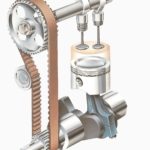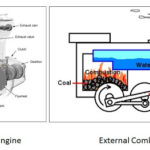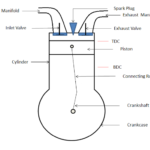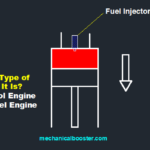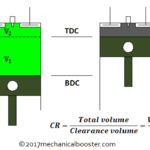What is Spark Ignition Engine?
It is an internal combustion engine in which the ignition of the air-fuel mixture takes place by the spark. The spark is generated with the help of a spark plug. Since in this engine, the spark is responsible for the ignition of the fuel, it is named as spark ignition engine (SI engine). This engine uses petrol as a fuel for its working. It works on the principle of the Otto cycle. The fuel in this engine is injected through the carburetor during suction stroke. The compression ratio of this engine is usually 6 to 10. It has a lightweight engine and is used in light-duty vehicles like motorcycles, cars, etc.
Main Components of SI Engine
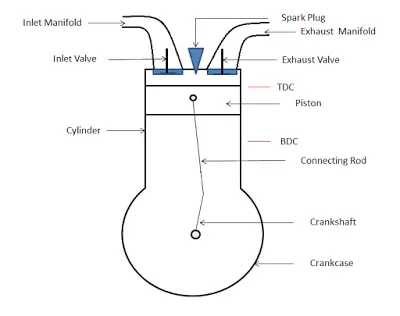
The main components of a spark ignition engine are as follows
- Inlet Valve: Air-fuel mixture enters into the cylinder through the inlet valve.
- Exhaust Valve: The burnt or exhaust gases produced in the power stroke escape out through the exhaust valve.
- Spark Plug: It produces spark at the end of the compression stroke, which ignites the compressed air-fuel mixture.
- Cylinder: It is a hollow cylinder in which the piston reciprocates.
- Piston: It is a moving part of the engine that performs reciprocating motion and transmits the power generated during power stroke to the crankshaft through a connecting rod.
- Connecting Rod: It is that part of the engine which connects the piston to the crankshaft.
- Crankshaft: It is used to convert the reciprocating motion of the engine into rotary motion.
Also Read:
- Different Types of Engine
- Difference Between SI Engine and CI Engine
- Car Dashboard Symbols And Meanings (Complete Guide)
Working Of SI Engine
Here we will discuss the working four-stroke engine. The working of a 4-stroke SI engine can be divided into four strokes.
1. Suction Stroke: Air-fuel mixture enters into the cylinder.
2. Compression Stroke: Compression of air-fuel mixture takes place.
3. Power Stroke: Combustion of Fuel and Power Generation.
4. Exhaust Stroke: Escaping of burnt gases out of the engine.
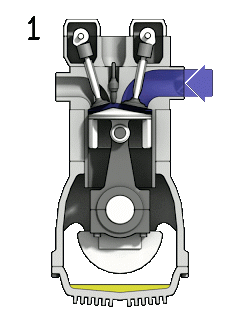
Lets us discuss each stroke in detail.
1. Suction Stroke
In this stroke, the piston moves downward and the air-fuel mixture from the carburetor enters into the cylinder through the inlet valve. During this stroke inlet valve opens and the exhaust valve remains closed.
2. Compression Stroke
In this stroke, the piston moves upward and compresses the air-fuel mixture. The compression strokes complete as the piston moves at TDC. During this stroke, Both the inlet and exhaust valve remain closed.
3. Power Stroke
At the end of the compression stroke, a spark is produced by the spark plug. This spark ignites the air-fuel mixture and combustion takes place in the combustion chamber. Due to combustion, a very high thrust force is generated which pushes the piston downward rapidly and makes the crankshaft to rotate. This stroke is called a power stroke because we get power in it. Both the inlet and exhaust valve remain closed in this stroke.
4. Exhaust Stroke
In this stroke, the piston moves upward, and burnt or exhaust gases produced in the power stroke escape out of the cylinder through the exhaust valve. In this stroke, the exhaust valve gets open and the inlet valve remains closed.
After the completion of the exhaust stroke, again all the four stroke repeats themselves. The most commonly used spark ignition engine are of two stroke engine and four stroke engine. In two stroke engine we have inlet and exhaust port instead of valve.
The position of the inlet and exhaust valve and the operation performed during all four strokes of the SI engine are given in the table below:
| S.no | Stroke | Inlet Valve | Exhaust Valve | Operation Performed |
| 1. | Suction stroke | Open | Closed | Suction of fuel |
| 2. | Compression stroke | Closed | Closed | Compression of fuel |
| 3. | Power stroke | Closed | Closed | Combustion of fuel |
| 4. | Exhaust stroke | Closed | Open | Escaping of burnt gases |
Application
The Spark ignition engine is used in automobiles (motorcycles, Scooters, cars, etc), aircraft, motorboats, and in small engines such as chainsaws, lawn mowers, etc.
Conclusion
Here we have discussed How Spark Ignition Works, its main parts, working and its application. If you find this article informative then don’t forget to share it.

